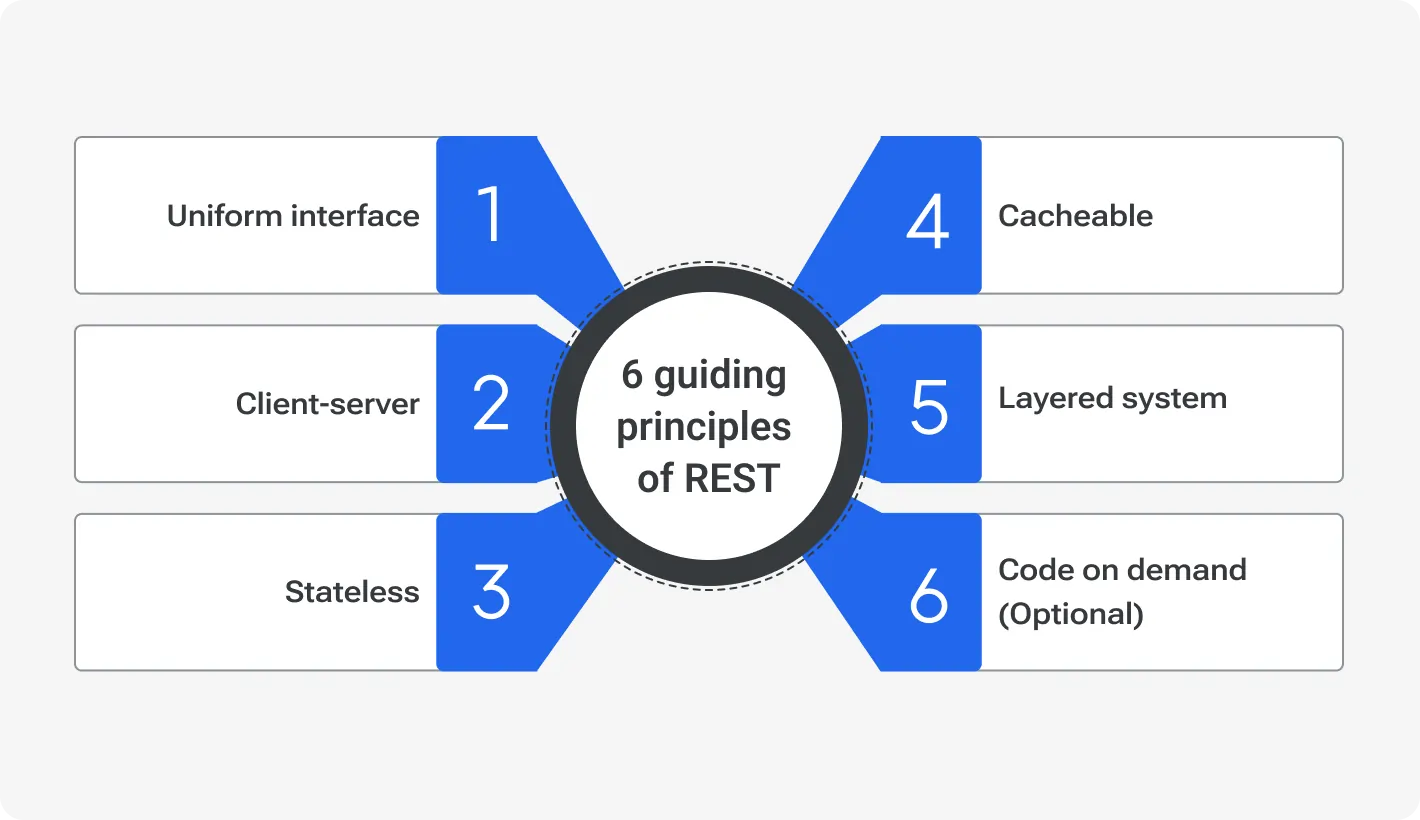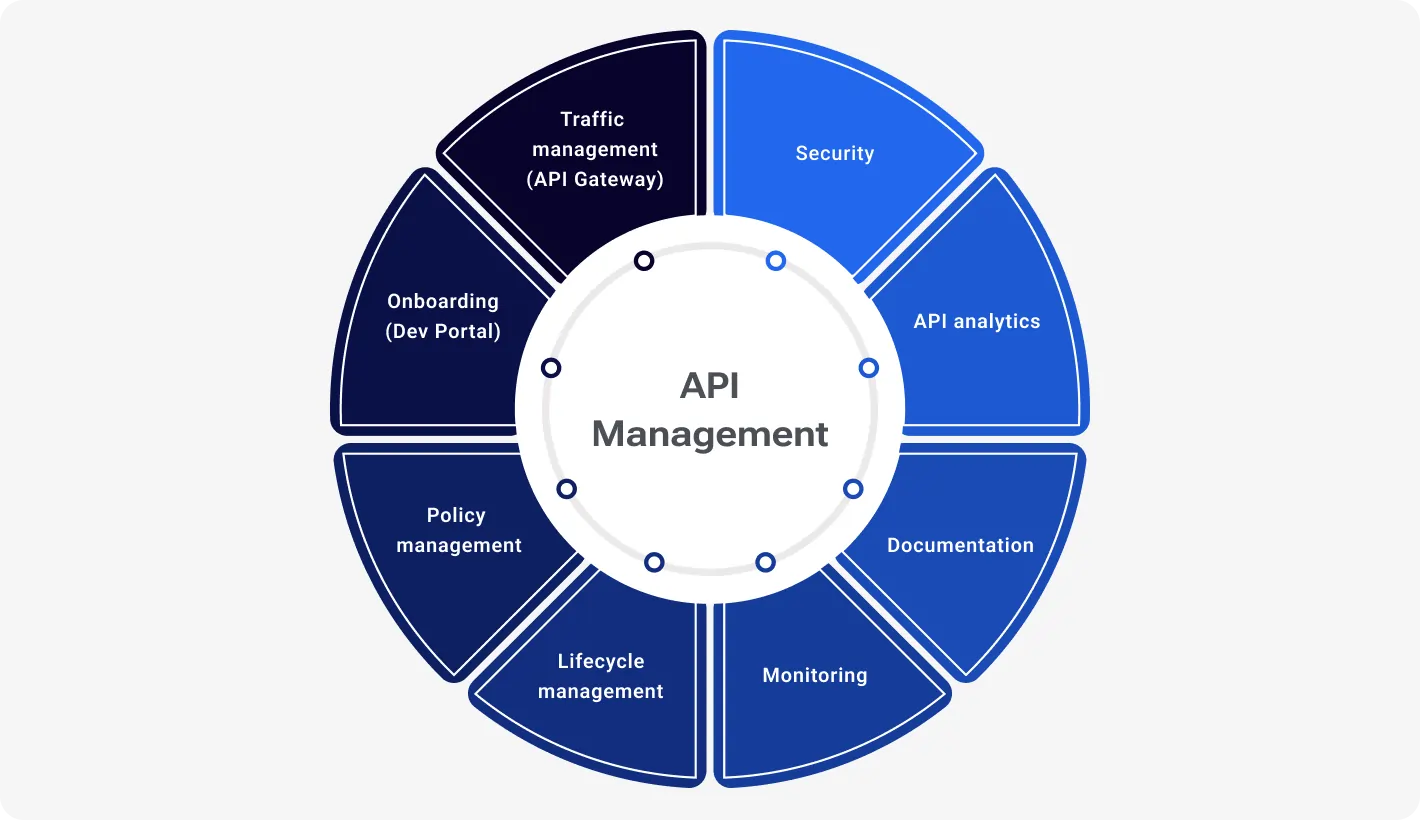APIs constitute a large part of modern software development: over 85% of successful businesses invest in API strategies to drive growth and innovation. If you aim to boost your business results than using APIs is definitely the right choice. However, to proceed with caution and mastery, you must outline the success checklist.
To help you successfully implement API into your business we have created a comprehensive checklist. Our API checklist will be divided into two parts: theoretical and practical. In the theoretical section, we will discuss the planning, design, and all the associated documentation for API development. The practical part, which is the most important one, will illustrate how you can wisely apply your API in practice. Read on to construct your own API development checklist.
Bridge the gap with seamless API solutions for product integration
Planning and strategy
Deployment and use of any API starts with careful planning and design. First and foremost, you must define your business objectives. Ask yourself: what do I need an API for? What purposes will it fulfill? Once your API initiative aligns with the overall goals of your business, you can move on to planning. When mapping out the future API, identify the needs and expectations of your target users.
For example, you need to integrate payment solutions for your clients. Look at it from the customers’ point of view: what features do you want to see in a payment window? What transaction options? What currencies? And what about the overall design? Develop a plan in which you outline all the pain points of the users and how exactly your API aims to solve them.
During the planning stage, engage key stakeholders early in the process to gather requirements and ensure alignment. In the end, you must take into consideration three main metrics: your business goals, the needs of your customers, and the expectations of your stakeholders.
Finally, don’t forget to establish clear key performance indicators (KPIs) to measure API success, such as response times, usage rates, and error rates. Uninterrupted testing and regular maintenance are the main components that support a stable API lifecycle.
The path to smooth API integration: Expert tips and tricks
Design and documentation
The next milestone to successful API development and deployment is design and documentation. Proper design will account for the usability of your API and the API documentation will provide transparent information on the nature, purpose, features, and versions of the API.
RESTful design
When you move on to designing your API, you can rely on RESTful design principles to ensure scalability and ease of use. These principles include:
Statelessness. Each request from a client to the server must contain all the information the server needs to fulfill it. This allows each API call to be independent, improving reliability and scalability.
Client-server separation. The client and server applications should be separated, allowing them to evolve independently. This separation improves flexibility and enables changes to the client or server without impacting the other.
Uniform interface. Use a consistent structure across endpoints (naming, methods, status codes, etc.). A uniform interface simplifies the API, making it intuitive for developers to understand and use.
Resource-based URLs. URLs should represent resources, not actions. For example, use /products to represent product data, with HTTP methods (like GET, POST, PUT, DELETE) to define actions.
Use of HTTP methods. RESTful APIs utilize HTTP methods to perform actions on resources GET to retrieve data, POST to create new resources, PUT to update existing resources, and DELETE to remove resources.
Representation of resources. Send resources in a format like JSON or XML, which is widely understood and easy to parse. RESTful design should allow different formats based on client needs.
Cacheability. Responses should allow clients to cache responses when appropriate. This can reduce server load and improve performance.

Consistency
The next crucial step is to maintain consistent naming conventions and data formats. You must do it in order to establish a clear hierarchy for your API: endpoint names, data representations, and response formats across the API. In this way, developers will understand how your API works easier and work with it faster. Here are some key tips:
-
Endpoint naming. Use consistent, intuitive, and descriptive names for each endpoint that represent resources clearly.
-
Data format consistency. Choose a standard format for data, such as JSON or XML, and stick with it across all responses and requests. JSON is commonly used for RESTful APIs due to its readability and compatibility with various systems.
-
Naming conventions for fields. Use a consistent convention for data field names. In this way, you can prevent errors when utilizing the API.
-
Error message format. Maker error message structures standard so clients can easily handle errors.
-
HTTP status codes. Use standard HTTP status codes for additional protection of your API.
These are the basic rules of API implementation that you should adhere to if you want your first experience with API design and implementation to go as smoothly as possible.
Versioning
Plan for API versioning to manage updates and backward compatibility. It is easier to manage an API and track any changes or improvements in it when you create a new version for every major update. During the versioning process, it is important to ensure backward compatibility so that, in case of any unforeseen errors or bugs in the newest version, users can return to the previous one effortlessly.
A surefire way to simplify this process is to integrate a GraphQL API. While REST-type APIs always require versioning whenever modified, GraphQL reduces this need almost to zero. This is due to such features as flexible field selection, built-in field deprecation, and a single evolving schema instead of constant versioning.
Documentation
After designing your API, it is important to describe it properly in writing and provide sufficient documentation. The package must include info on the API endpoints, examples of requests and responses, and usage instructions. They should be written in such a way that they are understandable both to developers and individuals who are far from being tech-savvy. When drafting documentation for your API, you should maintain the following structure:
explanation of authentication process;
status and error code definitions;
When it comes to APIs, interactive documentation is getting more and more widespread. You can use tools like Swagger or Postman to create an interactive documentation package for your API. Swagger allows you to define endpoints with the OpenAPI specification, enabling users to try requests directly in the documentation with the “Try it out” feature.
In Postman, you can create a collection of requests, add descriptions and example responses, then publish it as interactive documentation that lets users test API endpoints and view responses in real-time. Both tools streamline API onboarding, making it easier for developers to understand and test APIs effectively.
Choosing the right API development partner: What to look for
Development and testing
The next point on the API success strategies checklist is development supported by testing. In API development, it is crucial to follow the best practices that have been proven effective for different business types. The API best practices include:
Frameworks and tools. It is important to choose a development framework that suits your project goals. For example, Express for Node.js, Django for Python, or FastAPI for high-performance APIs. In the development process, you can once again resort to such tools as Swagger or Postman to document every separate stage as your API is being brought to life.
Coding standards. Adhere to effective coding standards and naming conventions to make your code readable and comprehensible to any developers working with it. The simplest way to do it is to use RESTful design principles. You can also implement version control practices like Git and review your code regularly in order to catch any bugs or other issues at the early stages.
Testing
The next step is testing. Before your API goes live and gets into the hands of the end-user, it requires long and meticulous testing. The three main approaches to it are unit and integration testing, automated testing, and security testing.
Unit and integration testing. Unit tests work best when you need to validate individual components of your API. Combine them with integration testing to see how well different parts of your API work together. Tools like Jest, Mocha, or JUnit are popular for unit tests, while Postman or Newman can be used for integration testing.
Automated testing. Use a continuous API testing tool that will regularly verify your API and save you time on manual work. This is one of the main ways to detect delays or bugs in the functions of your API at the early stages. Continuous integration tools like Jenkins, GitHub Actions, or CircleCI can automatically trigger tests and deployments.
Security testing. Security is no less important when it comes to API’s success; of anything, it is paramount. You need to be able to see all the vulnerabilities and be ready to promptly get rid of them. Tools like OWASP ZAP or Burp Suite for API security testing help ensure data protection and prevent any unauthorized access.
Security and compliance
Moving on with the checklist, ensuring security and regulatory compliance of your API is vital. No matter how advanced and simple in use your API is, if it’s not secure and safeguarded from unauthorized access, the project has failed. Therefore, here are the ways in which you can ensure the security and compliance of your API.
Authentication and authorization
The first step towards a secure API is implementing authentication and authorization procedures. The standard algorithm involves the use of OAuth2 and API keys.
OAuth2 is the most popular security tool for APIs. It allows users to grant third-party applications access to their resources without sharing any personal credentials. Instead, OAuth uses tokens.
API Keys are the best way to control access to your API and monitor its usage. The way it works is that every client application gets a unique key, which must be included in requests. This key helps identify and restrict API access in case of misuse, abuse, or privacy threats. API keys also enable rate-limiting and usage tracking for the same purpose.
Data protection
Protecting the data of your company and your clients alike is no less important when deploying an API. You can ensure data protection in two main ways: encryption and compliance.
Encryption is the simplest and most evident way to protect sensitive information. It is better to encrypt data both with HTTPS and using standards like AES. In this way, you will protect your API from unauthorized access and data breaches. This, in turn, will ensure compliance.
Depending on the country your company is registered in, different data protection regulations may apply. API, as an integral addition to your platform or app, should comply with them as well. Before deploying an API, check with your regulator the rules for data protection: for example, in the EU, all companies adhere to the GDPR for data protection. In addition, there are HIPAA for healthcare information and PCI-DSS for payment data.
Deployment and monitoring
Once your API is carefully planned out, designed, developed, tested, and secured, you can move on to the deployment and monitoring stages. According to Postman, 62% of respondents report working with APIs that generate income. For this to be true for your company, you must approach the deployment and monitoring stages with precision and care.
Deployment strategies
The first method of API deployment is using staging environments. A staging environment is a separate space in which developers can test an API before sharing it with end-users. This is basically the rehearsal for your API and its functions. The main features of staging environments include:
Testing ground. It provides developers with a safe space to detect and fix any bugs in the API that might not have been visible up to this stage.
Realistic setup. Staging environments usually resemble real API development and usage setups. They even include the same configurations, databases, or anonymized user data. The more realistic the conditions are the easier it is to detect performance issues.
Final checks. A staging environment provides developers with a final opportunity to run checks and confirm that the API behaves as expected.
Another deployment method involves using CI/CD pipelines. With this approach, you can ensure that any changes in your API’s code are constantly integrated and tested. This is basically an automated deployment where the CI/CD pipelines are responsible for aligning the changes with the API’s functions without interrupting its performance. For this, you can use tools like Jenkins, GitHub Actions, and GitLab CI/CD.
Monitoring
Once your API is deployed, you must regularly monitor its performance and user experience. Constant monitoring helps ensure that the API is working as designed and prevents small bugs from turning into sophisticated performance issues. The best approach to API monitoring is to set up monitoring tools like New Relic, Datadog, or Prometheus. They will collect and analyze API usage data to track such performance metrics as response times, error rates, and uptime.
Another integral part of API monitoring is usage analytics. The most widespread tools for usage analytics are Google Analytics, New Relic, Postman, and APM Tools. The key aspects of usage analytics include traffic monitoring, user behavior, performance metrics, error tracking, and security insights.
Maintenance and iteration
Finally, API integration can’t be fully successful without maintenance and iteration. This stage involves collecting user feedback and internal feedback, regular bug detection and fixes, and iterative development.
A feedback loop includes both user and internal feedback. You can collect user feedback directly in the API itself. Similarly, encourage your internal development teams to provide regular feedback on the API’s usability and overall performance;
Use an iterative development approach. To keep your API alive and functioning, make sure to continuously refine and enhance its functions and interface.
Develop and maintain your API based on both user and internal feedback. In addition, stay in line with the evolving trends in API development and follow them on time to stay relevant and cultivate the best results from API offerings for your platform.
Exemplary cases of API integration
According to Postman’s report on the state of API, 74% of respondents are API first in 2024, up from 66% in 2023, and APIs are no longer an afterthought but the foundation of development, with between 26 and 50 APIs powering the average application. You can see the fruits of successful API implementation in practically every website or app you use on a daily basis. Here are some examples that have particularly caught our eye.
Salesforce
Salesforce’s API is a popular tool in customer relationship management (CRM) software. It is widely used by businesses all over the world. The most common use cases include integration of existing databases or third-party systems, like NetSuite or SAP, thus ensuring seamless data exchange between different platforms.
On its API Library, Salesforce lists dozens of API types for different purposes: for instance, Account Engagement APIs, B2C Commerce APIs, Consumer Goods Cloud APIs, CRM Analytics REST APIs, Financial Services Cloud APIs, and many others. With Salesforce API offerings, businesses can synchronize customer data, sales, and support exchanges in real-time. In this way, they boost productivity and manage their customer interactions effectively. Here is how it works:
Data synchronization. It is possible to integrate Salesforce with external systems to ensure consistent and up-to-date information across platforms. The most popular use case is the synchronization of customer accounts.
Custom application development. Many companies use Salesforce’s APIs to develop custom apps tailored to the purposes of a particular business.
Real-time event monitoring. Salesforce also offers a Pub/Sub API to monitor and respond to data changes in real-time.
Skyscanner
The travel site Skyscanner uses APIs to aggregate flight, hotel, and car rental options. In this way, they are the fastest to provide the best options to users in real-time. Platforms that use Skyscanner’s API can integrate similar search systems and simplify travel planning. In its API Developer Documentation, Skyscanner explains how it can be done.
Through Skyscanner’s API, businesses can integrate similar search capabilities into their own platforms, simplifying travel planning by pulling data from airlines, hotels, and car rental agencies.
Travel search integration. Platforms that require data about flights promptly can use Skyscanner’s API to track and list the current best offers for website visitors or app users. The API pulls data from airline websites, other travel aggregators, hotels, and car rental agencies.
Data analysis. In addition, Skyscanner’s API scans geographical and cultural data based on the preferences of every user. In this way, it can tailor travel offerings to fit specific targeted markets.
Conclusion
All in all, the main points on the API development success checklist are planning and strategy, design and documentation, development and testing, security and compliance, deployment and monitoring, and maintenance and iteration. Each step is a component in an inseparable whole; therefore, excelling at every stage of the checklist is crucial for the smooth and uninterrupted functioning of your API.
We encourage you to refer to this checklist when working on an API deployment for your company. Are you falling behind at any of the checklist points? Сontact our team of API experts for rounded and personalized assistance in API development and deployment.
Struggling to connect your siloed systems? Hire a reliable API provider





